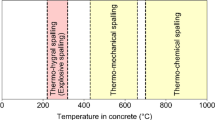Abstract
The stress-crack width relationship has been determined experimentally for concretes reinforced with two types of fibres, steel and polypropylene, of various fibre volume fractions. A micromechanics-based theoretical model is proposed which captures the essential features of the stress-crack width relationships at small crack widths (less than 0.3 mm).
Micromechanisms accounted for include the bridging actions due to aggregates and fibres, Cook-Gordon interface debonding and fibre pre-stress. The fibre bridging action involves interface slip-dependent friction as well as snubbing friction for fibres bridging at inclined angles. Theoretical predictions based on independent parametric inputs compare favourably with experimental measurements of the stress-crack width relationship. Findings in this research provide confidence in the use of the proposed model for materials engineering targeted at prescribed structural performance.
Resume
On a déterminé de façon expérimentale la relation contrainte-largeur de fissure pour des bétons renforcés par deux types de fibres—acier et polypropylène—avec différentes proportions en volume de fibres. On propose un modèle théorique basé sur la micromécanique, qui prend en compte les caractéristiques essentielles des relations contrainte-largeur de fissure pour des largeurs limitées (<0.3 mm). Les micromécanismes pris en considération comprennent l'effet de pontage, l'effet Cook-Gordon à l'interface et la précontrainte des fibres. L'effet de pontage des fibres implique un frottement en relation avec le glissement et un frottement qui relève les fibres se croisant à angles obliques. La comparaison entre les prédictions théoriques basées sur des paramétres indépendants et les mesures expérimentales de la relation contrainte-largeur de fissure est satisfaisante. Les résultats de cette recherche donnent confiance dans l'utilisation du modèle proposé pour des matériaux de génie civil destinés à des performances structurelles prescrites.
Similar content being viewed by others
References
Stang, H., ‘Evaluation of properties of cementitious materials’, in ‘High Performance Fiber Reinforced Cement Composites’, Proceedings of International RILEM/ACI Workshop, edited by H. W. Reinhardt and A. E. Naaman (Spon, 1992) pp. 388–406.
Li, V. C. and Liang, E., ‘Fracture processes in concrete and fibre-reinforced cementitious composites’,ASCE J. Eng. Mech. 12(6) (1986) 566–586.
Stang, H. and Aarre, T., ‘Evaluation of crack width in FRC with conventional reinforcement.J. Cem. Concr. Compos. 14(2) (1992) 143–154.
Li, V. C. and Wu, H. C., ‘Conditions for pseudo strain-hardening in fiber reinforced brittle matrix composites’,J. Appl. Mech. Rev. 45(8) (1992) 390–398.
Li, V. C. and Leung, C. K. Y., ‘Theory of steady state and multiple cracking of random discontinuous fiber reinforced brittle matrix composites’,ASCE J. Engng Mech. 118(11) (1992) 2246–2264.
Cook, J. and Gordon, J. E., ‘A mechanism for the control of crack propagation in all brittle systems’,Proc. Roy. Soc. 282A (1964) 508–520.
Stang, H., Li, V. C. and Krenchel, H., ‘Design and structural applications of stress-crack width relations in fiber reinforced concrete’, in preparation.
Ortiz, M., ‘Microcrack coalescence and macroscopic crack growth initiation in brittle solids’,Int. J. Solids Struct. 24 (1988) 231–250.
Horii, H., Hasegawa, A. and Nishino, F., ‘Fracture process and bridging zone model and influencing factors in fracture of concrete’, in ‘Fracture of Concrete and Rock’, edited by S. P. Shah and S. E. Swartz (Springer, New York, 1989), pp. 205–219.
Karihaloo, B. L. and Huang, X., ‘Tensile response of quasi-brittle materials’,Pure Appl. Geophys. 137(4) (1991) 461–427.
Li, V. C., Wang, Y. and Backer, S., ‘Effect of inclining angle, bundling, and surface treatment on synthetic fiber pull-out from a cement matrix’,J. Compos. 21(2) (1990) 132–140.
Li, V. C., ‘Post-crack scaling relations for fiber reinforced cementitious composites’,ASCE J. Mater. Civil Engng 4(1), (1992) 41–57.
Wang, Y., Li, V. C. and Backer, S., ‘Modeling of fiber pull-out from a cement matrix’,Int. J. Cem. Compos. Lightwt Concr. 10(3) (1988) 143–149.
Aarre, T., ‘Tensile Characteristics of FRC with Special Emphasis on its Applicability in a Continuous Pavement’, PhD thesis, Department of Structural Engineering, Technical University of Denmark (1992).
Glavind, M., ‘Evaluation of the Compressive Behavior of Fiber Reinforced High Strength Concrete’, PhD thesis, Department of Structural Engineering, Technical University of Denmark (1992).
Barsoum, M. W., Kangutkar, P. and Wang, A. S. D., ‘Matrix crack initiation in ceramic matrix composites. Part I: Experiments and test results’,Compos. Sci. Technol. 44 (1992) 257–269.
Bentur, A., Diamond, S. and Mindess, S., ‘Cracking process in steel fiber reinforced cement paste’,Cem. Concr. Res. 15 (1985) 331–342.
—Idem,, ‘The microstructure of steel fiber-cement interface’,J. Mater. Sci. 20 (1985) 3610–3620.
Bentur, A. and Mindess, S., ‘Fiber Reinforced Cementitious Composites’ (Elsevier Applied Science, 1990) p. 449.
Cox, H. L., ‘The elasticity and strength of paper and other fibrous materials’,Br. J. Appl. Phys.,3 (1952) 72–79.
Krenchel, H., ‘Fibre Reinforcement’ (Akademisk, Copenhagen, 1964) p. 159.
Laws, V., ‘The efficiency of fibrous reinforcement of brittle matrices’,J. Phys. D: Appl. Phys. 4 (1971) 1737–1746.
Hordijk, D. A., Van Mier, J. G. M. and Reinhardt, H. W., ‘Material properties’, in ‘Fracture Mechanics of Concrete Structures, From Theory to Applications’, edited by L. Elfgren (Chapman and Hall, London, 1991) pp. 67–127.
Petersson, P.-E., ‘Crack Growth and Development of Fracture Zones in Plain Concrete and Similar Materials’. Report TVBM-1006 (Division of Building Materials, Lund Institute of Technology, 1981).
Hansen, S. and Stang, H., ‘Experimentally Determined Mechanical Properties for Fiber Concrete’ (Report Series R, No. 305, Department of Structural Engineering, Technical University of Denmark, 1993).
Thygesen, E., ‘Design of FRC-materials and Structures’, PhD thesis, Department of Structural Engineering, Technical University of Denmark (1992) (in preparation, in Danish).
Stang, H., ‘Indirect determination of interfacial strength parameters’, in preparation.
Aveston, J., Cooper, G. A. and Kelly, A., ‘Single and multiple fracture’, in ‘Properties of Fiber Composites’, Conference Proceedings (IPC Science and Technology, 1971) pp. 15–24.
Visalvanish, K. and Naaman, A. E., ‘Fracture modelling for fiber reinforced cementitious composites’, Program Report for NSF Grant ENG 77-23534 (Department of Materials Engineering, University of Illinois at Chicago Circle, Chicago, 1982).
Bentur, A., personal communication.
Author information
Authors and Affiliations
Rights and permissions
About this article
Cite this article
Li, V.C., Stang, H. & Krenchel, H. Micromechanics of crack bridging in fibre-reinforced concrete. Materials and Structures 26, 486–494 (1993). https://doi.org/10.1007/BF02472808
Issue Date:
DOI: https://doi.org/10.1007/BF02472808




